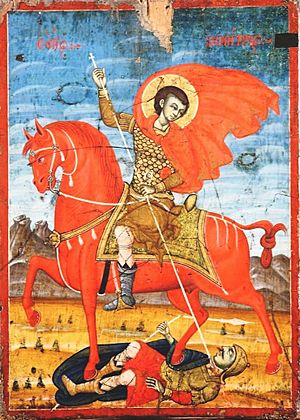Kostandin Shpataraku facts for kids

Kostandin Shpataraku (1736-1767) was a famous Albanian painter. He is also known simply as Shpataraku. He was known for painting religious pictures called icons and wall paintings called frescoes. He lived in the 1700s, a time known as the Post-Byzantine period.
Shpataraku was special because he mixed old Byzantine art styles with new ideas from the Renaissance. People see him as one of the most important artists from medieval Albanian art. Other famous Albanian painters from that time include Onufri and David Selenica.
His Life and Legacy
Kostandin Shpataraku was born in a place called Shpat. This area is near the city of Elbasan in Albania. At that time, Albania was part of the Ottoman Empire.
Sadly, Kostandin Shpataraku was killed by the Ottoman authorities in Elbasan. His family secretly took his body. They buried him in his home village. To keep his grave a secret, they buried his head separately. This way, the Ottomans could not find his exact burial spot. Later, a small chapel was built to remember him. Local people also remember him as a saint every year on September 21.
His Art and Works
Kostandin Shpataraku's art is special because of his small, detailed paintings called miniatures. He often added scenes from everyday life into his art. This made his work unique and interesting.
You can find his paintings, including icons and frescoes, in several places. Some are in the Ardenica Monastery and St. Jovan Vladimir's Church. Many of his artworks are also owned by private collectors.
Some of his works have been carefully collected and fixed. Today, you can see them in museums. These include the National Museum of Medieval Art in Korçë. You can also find his art at the National Iconographic Museum in Berat.
A Famous Painting
In 2010, one of his icon paintings was sold for a lot of money. It was bought by a person named Hetem Ramadani for 75,000 euros. This happened at a special charity event. The event was hosted by Liri Berisha, who is the wife of a former Albanian leader. This icon used to belong to the family of a modern painter named Alush Shima.
Images for kids
-
An icon attributed to Kostandin Shpataraku.


